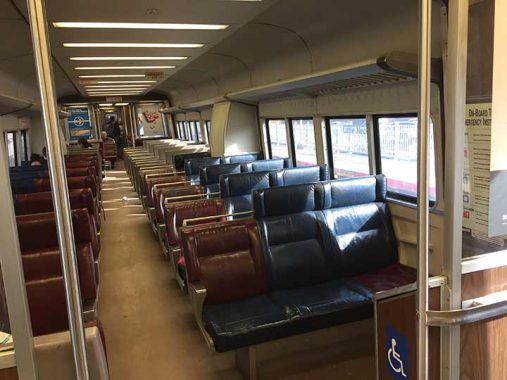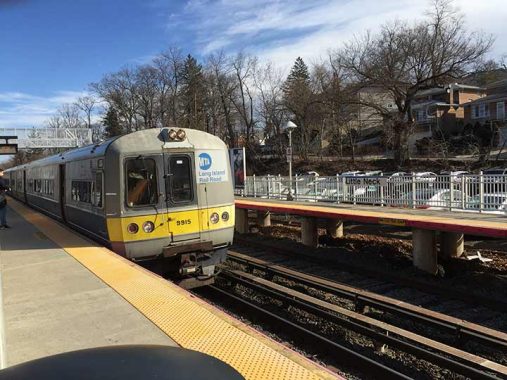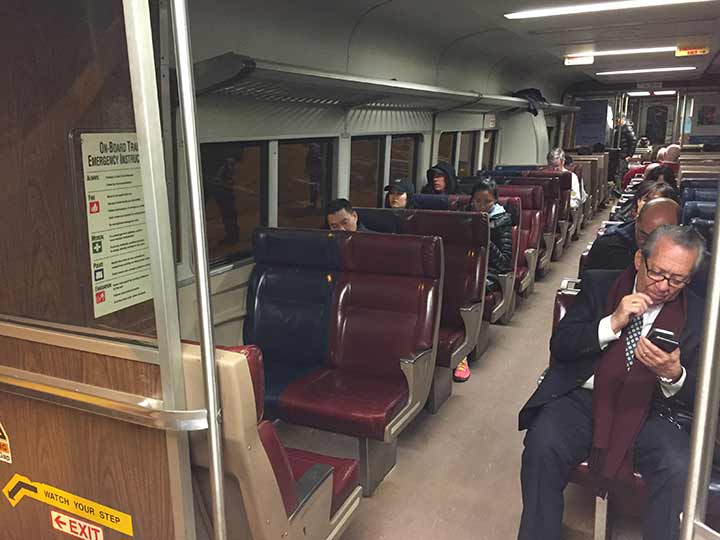
I was always sure to photograph the interior or exterior of a M-1 or M-3 Long Island Rail Road car whenever one pulled into the station where I was waiting. M-1s, introduced in the early 1970s, were retired long ago but their near-lookalikes, the M-3s, which arrived around 1980, ran until just recently; though supposedly all replaced by new M-9s by 2020, there were mechanical problems with the new cars, so the old reliables were trundled out for one last run, though not on my branch, the Port Washington, as far as I could tell.
I got this shot en route to a night shift job in the spring of 2018. This is typical of the M-3, with its blue and red upholstered seats arranged in sets of two and three opposite each other. If I was getting on at the first stop, I made sure to get the window in one of the three-seaters, since if the train got crowded, the last seat anyone wanted was the middle seat in a set of three. In fact even on crowded cars a lot of those seats went untenanted. Thus, I could be assured of some space next to me I’d say a good 6 or 7 times out of ten.
When I took the LIRR to my job in Port Washington from 1992-1999 and again from 2006-2011, I could often be found walking through the cars at the first stop in Port on the way home. Why? People often left their New York Posts and Daily Newses in the seats from the prior run, and I collected a free newspaper more often than not.

The decor was faux wood paneling on the vestibules. The exterior of the cars closely resembled the subway cars that were being produced at the time, the R42 through R-68. When the door opened, a shrill whistle was heard, in contrast to the ‘bing bong’ on the newer M-7 and M-9s. The seats were roomier and the windows a bit larger. One issue the older cars had that hasn’t been solved in the newer cars is that the glass used in the windows tends to cataract or cloud over the more the sun shines on them; this is an issue that subway cars that spend a lot of time outdoors on els don’t have. In some cars the windows are so opaque you need to depend on recorded station announcements, introduced in the M-7 and M-9 (I’m not sure who does them, that you, Charlie Pellet? Bernie Wagenblast?) to know where you are!

More observations: M-3s featured a band of yellow, continued in the M-7, that made them distinctive; the feature has vanished in the M-9. After awhile, the sinks in the M-3 restrooms vanished; if you needed to use the restrooms, you washed your hands when you got home. Adjacent to the restrooms there was the heady aroma of all varieties of human waste mixed with disinfectant.
I don’t know why the M-5 was skipped; I imagine it was an M-7 prototype that didn’t make it to the tracks. (I don’t know what the M stands for.) If you’re wondering where the even numbers are, Metro North car makes are numbered evenly.
(See Comments for clarification on issues mentioned here)
As always, “comment…as you see fit.” I earn a small payment when you click on any ad on the site. Take a look at the new JOBS link in the red toolbar at the top of the page on the desktop version, as I also get a small payment when you view a job via that link.
12/19/24


11 comments
Hi there—
M3 cars are still in service on the LIRR. There are still 85 sets of 2 in the LIRR roster of rolling stock that combine to make various lengths of 4,6,8,10, and 12 car train sets.
These are heavily used on the Brooklyn shuttle as 4 and 6 car sets. They also appear on Babylon, Hempstead, Long Beach, and Far Rockaway services most often with occasional Ronkonkoma, Huntington, and W Hempstead services. As Port Washington doesnt run through Jamaica, it is less likely to be serviced by the M3.
M3A cars are also in service on the MNRR Hudson and Harlem divisions.
M stands for Metropolitan, which is the stylistic name given to the original BUDD design in the 1960s.
M5 trains were made in the 1990s for MNRR in limited number. They were never purchased for the LIRR as the M1 and M3 fleet were more than adequate at the time. The M5 was nearly identical to the M3.
The M2, M4, M6 and M8 cars have overhead electrical connections used exclusively by MNRR Connecticut services.
The LIRR capital program has ordered M9A cars to replace the remaining M3 fleet between 2025-2029.
Happy Holidays!
As of 2024 LIRR has 100 active M3 cars in its fleet – or 50 separate pairs. As the poster noted, they are most often found on the Jamaica-Brooklyn shuttles. They also can be found on some trains that operate to and from Penn Station. They are not assigned to any Grand Central trains. Like all other LIRR electric trains, they are multiple unit (MU) trains that operate with permanently coupled pairs of cars, meaning that train consists must be an even number -4, 6, 8, 10, or 12 cars.
With regard to the Metro North, the M2, M4, and M6 fleets are now completely retired. M8 cars completely cover all Metro-North MU electric train services. The small M4 and M6 fleets were three-car units; M2 and M8 are the more traditional married pairs, with the exception of 25 single unpowered M8 trailer cars.
Let me correct my own posting. I wrote, “With regard to the Metro North, the M2, M4, and M6 fleets are now completely retired. M8 cars completely cover all Metro-North MU electric train services.” Haste makes waste. My corrections are in CAPS. Should have said, “With regard to the Metro North NEW HAVEN LINE SERVICE, the M2, M4, and M6 fleets are now completely retired. M8 cars completely cover all Metro-North NEW HAVEN LINE MU electric train services.” The Hudson and Harlem Lines have their own separate fleets of M3A and M7 cars. My apologies to all for posting incorrect information.
My guess, as someone who operates them, is there are 82 cars total still in service, with more than a few of those unavailable on any given day.
Another interesting fact about the M1 thru M9 pairs is that all even numbered cars face East and all odd numbered cars face West.
On he LIRR, all sets are that way. The front car of any train heading east will be an even number and for all trains heading west, the lead car will be an odd number. Since one side of all cars will be on the north and the other side of all cars will always be facing south, it is those south-facing windows that suffer from the sun and become opaque. Such conditions are rarely found on the north side of the train cars. Lastly, some first-responders on Long Island, who might respond to railroad situations, are told “Odd car – odd smell”. That helps them remember that toilets are located in the odd numbered cars.
I remember when the LIRR had bar cars so you could get loaded on your way home
from work
Metro North had bar cars too. And for a while you could even smoke in them.
Correct me if I’m wrong, but the M-5 was supposed to be a single car instead of a married pair.Not sure if for the LIRR, Metro North or both.
The M5 was a single unit MU, with cabs on both ends, intended to replace the1962/1965 ACMUs in the early 1990s.
Asking for obvious reasons. Is 9946 still in service? Just Curious. I was A LIRR Conductor fro.m 1973 through 2006. No need to mention why, just asking